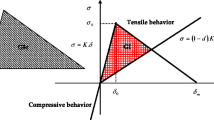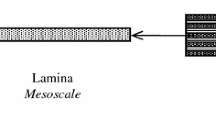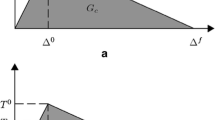A progressive interlaminar damage model, based on the Northwestern University theory and a trapezoidal trilinear traction-separation law, is presented to predict the initiation and propagation of delamination in layered composites under Mode I and Mode II loadings. The capability and reliability of the damage model proposed is assessed by comparing its results with experimental data. It was found that the model was able to accurately predict the maximum load and postfailure behavior of composite laminates. The model proposed was also compared with the Abaqus inbuilt cohesive surface model, which is also based on a bilinear tractionseparation law, and our model was found to give more accurate results.








Similar content being viewed by others
References
B. Z. Haque and J. W. Gillespie, “Finite element modeling of impact, damage evolution and penetration of thick-section composites,” Int. J. Impact Eng., 38, 181-197, (2011).
M. Kashtalyan and C. Soutis, “Modelingstiffness degradation due to matrix cracking in angleply composite laminates,” Plast. Rubber Compos. Process. Appl., 29, 482-488, (2000).
G. Lampeas, K. Fotopoulos, and N. Perogamvros, “Development and experimental validation of explicit dynamics simulation of composite structures using a stacked thick-shell methodology,” Plast. Rubber Compos., 45, 58-67, (2016).
S. Yazdani, W. J. H. Rust, and P. Wriggers, “An XFEM approach for modelingdelamination in composite laminates,” Compos. Struct., 135, 353-364, (2016).
O. Allix and P. Ladevèze, “Interlaminar interface modelingfor the prediction of delamination,” Compos. Struct., 22, 235-242, (1992).
J. Herwan, A. Kondo, S. Morooka, et al., “Finite element analysis of mode II delamination suppression in stitched composites using cohesive zone model,” Plast. Rubber Compos., 44, 390-396, (2015).
M. Heidari-Rarani and A. R. Ghasemi, “Appropriate shape of cohesive zone model for delamination propagation in ENF specimens with R-curve effects,” Theor. Appl. Fract. Mech., 90, 174-181, (2017).
R. K. Joki, F. Grytten, B. Hayman, et al., “Determination of a cohesive law for delamination modeling- Accounting for variation in crack opening and stress state across the test specimen width,” Compos. Sci. Technol., 128, 49-57, (2016).
A. Turon, P. P. Camanho, J. Costa, et al., “Accurate simulation of delamination growth under mixed-mode loading using cohesive elements: Definition of interlaminar strengths and elastic stiffness,” Compos. Struct., 92, 1857-1864, (2010).
I. M. Daniel, B. T. Werner, and J. S. Fenner, “Strain-rate-dependent failure criteria for composites,” Compos. Sci. Technol., 71, 357-364, (2011).
V. Tvergaard and J. W. Hutchinson, “The relation between crack growth resistance and fracture process parameters in elastic-plastic solids,” J. Mech. Phys. Solids., 40, 1377-1397, (1992).
T. K. O’Brien, “Interlaminar fracture toughness: the long and winding road to standardization,” Compos. Part B Eng., 29, 57-62, (1998).
P. P. Camanho and C. G. Davila, “Mixed-mode decohesion finite elements for the simulation of delamination of composite materials,” NASA, TM-2002-21, 1-37, (2002).
ASTM. Standard Test Method for Mode I Interlaminar Fracture Toughness of Unidirectional Fiber-Reinforced Polymer Matrix Composites, D5528-14, West Conshohocken, PA. 2014.
International Standards Organization. BSEN. 15024. Fibre-reinforced plastic composites. Determination of mode I interlaminar fracture toughness. GIC, for unidirectionally reinforced materials (2001).
M. H. Salek, Effect of Processing Parameters on the Mechanical Properties of Carbon/PEKK Thermoplastic Composite Materials, Concordia University, Canada, (2005).
B. Derisi, S. V. Hoa, D. Xu, et al., “Mechanical behavior of carbon/PEKK thermoplastic composite tube under bending load,” J. Thermoplast. Compos. Mater., 24, 29-49, (2011).
ASTM. Standard Test Method for Determination of the Mode II Interlaminar Fracture Toughness of Unidirectional Fiber-Reinforced Polymer Matrix Composites, D7905/D7905M-14, West Conshohocken, PA. (2014).
C. Bouvet, S. Rivallant, and J. J. Barrau, “Low velocity impact modeling in composite laminates capturing permanent indentation,” Compos. Sci. Technol., 72, 1977-88, (2012).
Acknowledgement
This work was funded by the National Science Foundation of China (contract No. 41602373, 51905353) and the China Postdoctoral Science Foundation Grant (2018M631817).
Author information
Authors and Affiliations
Corresponding author
Additional information
Russian translation published in Mekhanika Kompozitnykh Materialov, Vol. 56, No. 6, pp. 1067-1080, November-December, 2020.
Rights and permissions
About this article
Cite this article
Wang, Z.Z., Zhao, J., Ma, X. et al. Numerical Simulation of Progressive Delamination in Composite Laminates Under Mode I and Mode II Loadings. Mech Compos Mater 56, 735–746 (2021). https://doi.org/10.1007/s11029-021-09919-4
Received:
Accepted:
Published:
Issue Date:
DOI: https://doi.org/10.1007/s11029-021-09919-4




